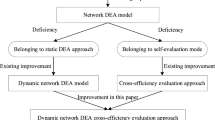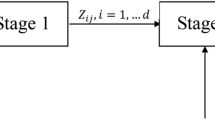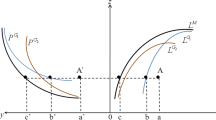Abstract
The high-tech industry in China has largely developed in recent decades. To provide a basis for the sustainable development of high-tech industry, the government should evaluate its performance to find out its strengths and weaknesses that are critical for the future improvement of business operations. Dynamic network data envelopment analysis has received considerable attention from researchers evaluating the performance of a system during long-term production. However, studies on the issue of shared outputs caused by the lagged production effect of inputs are rare. In a real high-tech industry, the outputs during a production period are derived from the inputs in that production period and also from the inputs in the previous period. These intertemporal shared outputs in a system cannot be easily divided into different periods. Thus, a new dynamic two-stage data envelopment analysis approach is proposed to measure the efficiency of such system with a two-stage structure and shared outputs. We divide a high-tech activity system into two stages: technology research and development stage and technology digestion and absorption stage, where intertemporal shared outputs occur. Empirical results from our approach indicate that Chinese high-tech industries are weak in the technology digestion and absorption stage. Finally, suggestions are provided to improve the overall efficiency of Chinese high-tech industries.



Similar content being viewed by others
References
Akther, S., Fukuyama, H., & Weber, W. L. (2013). Estimating two-stage network slacks-based inefficiency: An application to Bangladesh banking. Omega,41(1), 88–96.
An, Q., Chen, H., Xiong, B., Wu, J., & Liang, L. (2017). Target intermediate products setting in a two-stage system with fairness concern. Omega,73, 49–59.
An, Q., Meng, F., Ang, S., & Chen, X. (2018a). A new approach for fair efficiency decomposition in two-stage structure system. Operational Research,18(1), 257–272.
An, Q., Meng, F., & Xiong, B. (2018b). Interval cross efficiency for fully ranking decision making units using DEA/AHP approach. Annals of Operations Research. https://doi.org/10.1007/s10479-018-2766-6.
Avkiran, N. K. (2015). An illustration of dynamic network DEA in commercial banking including robustness tests. Omega,55, 141–150.
Avkiran, N. K., & McCrystal, A. (2014). Dynamic network range-adjusted measure vs. dynamic network slacks-based measure. Journal of the Operations Research Society of Japan,57(1), 1–14.
Castelli, L., Pesenti, R., & Ukovich, W. (2010). A classification of DEA models when the internal structure of the decision making units is considered. Annals of Operations Research,173(1), 207–235.
Charnes, A., Cooper, W. W., & Rhodes, E. (1978). Measuring the efficiency of decision making units. European Journal of Operational Research,2(6), 429–444.
Chen, C. M. (2009). A network-DEA model with new efficiency measures to incorporate the dynamic effect in production networks. European Journal of Operational Research,194(3), 687–699.
Chen, Y., Cook, W. D., Li, N., & Zhu, J. (2009). Additive efficiency decomposition in two-stage DEA. European Journal of Operational Research,196(3), 1170–1176.
Chen, C. M., & van Dalen, J. (2010). Measuring dynamic efficiency: Theories and an integrated methodology. European Journal of Operational Research,203(3), 749–760.
Chen, C. J., Wu, H. L., & Lin, B. W. (2006). Evaluating the development of high-tech industries: Taiwan’s science park. Technological Forecasting and Social Change,73(4), 452–465.
Cook, W. D., Liang, L., & Zhu, J. (2010). Measuring performance of two-stage network structures by DEA: A review and future perspective. Omega,38(6), 423–430.
Cook, W. D., & Zhu, J. (Eds.). (2014). Data envelopment analysis: A handbook of modeling internal structure and network, (Vol. 208). Berlin: Springer.
Färe, R., & Grosskopf, S. (1996). Intertemporal production frontiers: With dynamic DEA. Dordrech: Norwelh Kluwer.
Färe, R., Grosskopf, S., Karagiannis, G., & Margaritis, D. (2017). Data envelopment analysis and its related linear programming models. Annals of Operations Research,250(1), 37–43.
Golany, B. (1988). Note—A note on including ordinal relations among multipliers in data envelopment analysis. Management Science,34(8), 1029–1033.
Guan, J., & Chen, K. (2010). Measuring the innovation production process: A cross-region empirical study of China’s high-tech innovations. Technovation,30(5), 348–358.
Guan, J., & Chen, K. (2012). Modeling the relative efficiency of national innovation systems. Research Policy,41(1), 102–115.
Halkos, G. E., Tzeremes, N. G., & Kourtzidis, S. A. (2014). A unified classification of two-stage DEA models. Surveys in Operations Research and Management Science,19(1), 1–16.
Hashimoto, A., & Haneda, S. (2008). Measuring the change in R&D efficiency of the Japanese pharmaceutical industry. Research Policy,37(10), 1829–1836.
Herrera-Restrepo, O., Triantis, K., Trainor, J., Murray-Tuite, P., & Edara, P. (2016). A multi-perspective dynamic network performance efficiency measurement of an evacuation: A dynamic network-DEA approach. Omega,60, 45–59.
Hsieh, L. F., & Lin, L. H. (2010). A performance evaluation model for international tourist hotels in Taiwan—An application of the relational network DEA. International Journal of Hospitality Management,29(1), 14–24.
Hu, J., Yang, Y., Zhang, X., & Chen, X. (2017). Similarity and entropy measures for hesitant fuzzy sets. International Transactions in Operational Research. https://doi.org/10.1111/itor.12477.
Huergo, E., & Jaumandreu, J. (2004). Firms’ age, process innovation and productivity growth. International Journal of Industrial Organization,22(4), 541–559.
Ichniowski, C., Shaw, K., & Prennushi, G. (1997). The effects of human resource management practices on productivity: A study of steel finishing lines. The American Economic Review,87(3), 291–313.
Kao, C. (2009). Efficiency decomposition in network data envelopment analysis: A relational model. European Journal of Operational Research,192(3), 949–962.
Kao, C. (2014). Network data envelopment analysis: A review. European Journal of Operational Research,239(1), 1–16.
Kao, C., & Hwang, S. N. (2008). Efficiency decomposition in two-stage data envelopment analysis: An application to non-life insurance companies in Taiwan. European Journal of Operational Research,185(1), 418–429.
Kawaguchi, H., Tone, K., & Tsutsui, M. (2014). Estimation of the efficiency of Japanese hospitals using a dynamic and network data envelopment analysis model. Health Care Management Science,17(2), 101–112.
Kou, M., Chen, K., Wang, S., & Shao, Y. (2016). Measuring efficiencies of multi-period and multi-division systems associated with DEA: An application to OECD countries’ national innovation systems. Expert Systems with Applications,46, 494–510.
Krivonozhko, V. E., Førsund, F. R., & Lychev, A. V. (2017). On comparison of different sets of units used for improving the frontier in DEA models. Annals of Operations Research,250(1), 5–20.
Lee, T., Zhang, Y., & Jeong, B. H. (2016). A multi-period output DEA model with consistent time lag effects. Computers & Industrial Engineering,93, 267–274.
Li, L. B., Liu, B. L., Liu, W. L., & Chiu, Y. H. (2017). Efficiency evaluation of the regional high-tech industry in China: A new framework based on meta-frontier dynamic DEA analysis. Socio-Economic Planning Sciences,60, 24–33.
Liang, L., Cook, W. D., & Zhu, J. (2008). DEA models for two-stage processes: Game approach and efficiency decomposition. Naval Research Logistics,55(7), 643–653.
Moreno, P., & Lozano, S. (2018). Super SBI dynamic network DEA approach to measuring efficiency in the provision of public services. International Transactions in Operational Research,25(2), 715–735.
Sahoo, B. K., Kerstens, K., & Tone, K. (2012). Returns to growth in a nonparametric DEA approach. International Transactions in Operational Research,19(3), 463–486.
Seiford, L. M., & Zhu, J. (1999). Profitability and marketability of the top 55 US commercial banks. Management Science,45(9), 1270–1288.
Sun, H. (2011). R&D inputs, Outputs and its efficiency of high-tech enterprises: Evidence from Zhejiang Province. Proceedings of The Twelfth West Lake International Conference on Small & Medium Business, 2010, 913–917.
Tone, K., & Tsutsui, M. (2014). Dynamic DEA with network structure: A slacks-based measure approach. Omega,42(1), 124–131.
Tseng, Y. F., Lee, T. Z., & Wu, C. H. (2010). Examining the impact of human resource practices on organizational performance by using the AHP/DEA model. International Journal of Innovative Computing, Information and Control,6(8), 3401–3412.
Wu, Y. (2009). An empirical analysis on technical efficiency of China’s hi-tech industry. Proceedings of 2009 International Conference on Education Management and Engineering, 2009, 561–566.
Wu, C., Li, Y., Liu, Q., & Wang, K. (2013). A stochastic DEA model considering undesirable outputs with weak disposability.Mathematical and Computer Modelling, 58(5–6), 980–989.
Wu, J., Yu, Y., Zhu, Q., An, Q., & Liang, L. (2018). Closest target for the orientation-free context-dependent DEA under variable returns to scale. Journal of the Operational Research Society. https://doi.org/10.1080/01605682.2017.1409865.
You, Y. Q., & Jie, T. (2014). A study of the operation efficiency and cost performance indices of power-supply companies in China based on a dynamic network slacks-based measure model. Omega,60, 85–97.
Yu, M. M., Chen, L. H., & Hsiao, B. (2016). Dynamic performance assessment of bus transit with the multi-activity network structure. Omega,60, 15–25.
Zha, Y., Liang, N., Wu, M., & Bian, Y. (2016). Efficiency evaluation of banks in China: A dynamic two-stage slacks-based measure approach. Omega,60, 60–72.
Zhang, L., & Chen, Y. (2018). Equivalent solutions to additive two-stage network data envelopment analysis. European Journal of Operational Research,264(3), 1189–1191.
Zhang, R., Sun, K., Delgado, M. S., & Kumbhakar, S. C. (2012). Productivity in China’s high technology industry: Regional heterogeneity and R&D. Technological Forecasting and Social Change,79(1), 127–141.
Acknowledgements
The research is supported by National Natural Science Foundation of China (No. 71501189; 71571192), Natural Science Foundation of Hunan Province (2017JJ3397), the open project of “Mobile Health” Ministry of Education-China Mobile Joint Laboratory of Central South University, the Innovation-Driven Project of Central South University (No. 2018CX039), the State Key Program of National Natural Science of China (Nos. 71431006, 71631008). Major Project for National Natural Science Foundation of China (71790615). Key Laboratory of Hunan Province for New Retail Virtual Reality Technology, Hunan University of Commerce (2017TP1026).
Author information
Authors and Affiliations
Corresponding author
Rights and permissions
About this article
Cite this article
An, Q., Meng, F., Xiong, B. et al. Assessing the relative efficiency of Chinese high-tech industries: a dynamic network data envelopment analysis approach. Ann Oper Res 290, 707–729 (2020). https://doi.org/10.1007/s10479-018-2883-2
Published:
Issue Date:
DOI: https://doi.org/10.1007/s10479-018-2883-2




